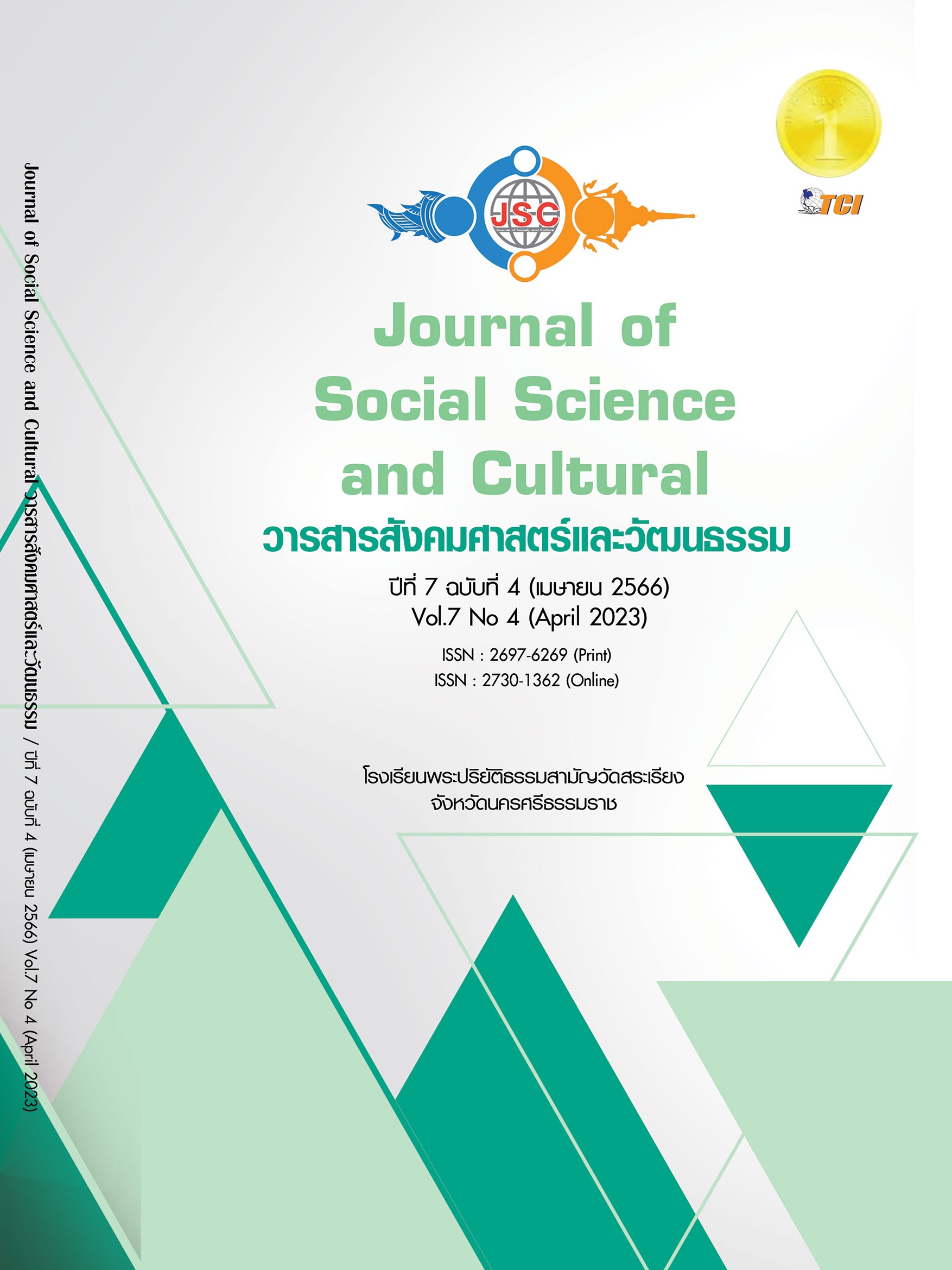การพัฒนารูปแบบการสอนภาษาอังกฤษตามแนวคิดการอ่าน แบบปฏิสัมพันธ์ร่วมกับการอ่านแบบกว้างขวางเพื่อส่งเสริมความสามารถในการอ่านอย่างมีวิจารณญาณของนักเรียน ชั้นมัธยมศึกษาตอนปลายในโรงเรียนสาธิต
Main Article Content
บทคัดย่อ
การวิจัยแบบผสมผสานนี้มีวัตถุประสงค์เพื่อ 1) ศึกษาสภาพการเรียนการสอนอ่านภาษาอังกฤษของนักเรียนชั้นมัธยมศึกษาตอนปลายในโรงเรียนสาธิต 2) พัฒนาและหาคุณภาพรูปแบบการสอนภาษาอังกฤษตามแนวคิดการอ่านแบบปฏิสัมพันธ์ร่วมกับการอ่านแบบกว้างขวางเพื่อส่งเสริมความสามารถในการอ่านอย่างมีวิจารณญาณของนักเรียนชั้นมัธยมศึกษาตอนปลายในโรงเรียนสาธิต 3) ทดลองใช้รูปแบบการสอนฯ และ 4) ปรับปรุงรูปแบบการสอนที่พัฒนาขึ้น การวิจัยเชิงคุณภาพโดยใช้แบบสัมภาษณ์ผู้สอนและนักเรียน การได้มาซึ่งกลุ่มตัวอย่างโดยการเลือกแบบเจาะจง การวิจัยเชิงปริมาณใช้แบบประเมินรูปแบบการสอน คู่มือการใช้รูปแบบการสอน แบบทดสอบความสามารถในการอ่านอย่างมีวิจารณญาณ ใช้การสุ่มตัวอย่างแบบหลายขั้นตอนได้นักเรียนชั้นมัธยมศึกษาปีที่ 4 โรงเรียนสาธิต มศว ปทุมวัน จำนวน 37 คน การวิเคราะห์ข้อมูลใช้สถิติค่าเฉลี่ย ส่วนเบี่ยงเบนมาตรฐาน ค่าที และการวิเคราะห์เนื้อหาบทสัมภาษณ์และความคิดเห็นของนักเรียนและผู้สอนเกี่ยวกับกิจกรรมการเรียนการสอน ผลการวิจัยพบว่า รูปแบบการสอนที่พัฒนาขึ้นมีองค์ประกอบคือ หลักการ วัตถุประสงค์ เนื้อหา ขั้นตอนการจัดกิจกรรมการเรียนการสอนประกอบด้วย 5 ขั้นตอน คือ 1) ขั้นกระตุ้น 2) ขั้นเตรียมความรู้ 3) ขั้นการอ่านแบบปฏิสัมพันธ์ 4) ขั้นสรุปและประเมินผล 5) ขั้นขยายความรู้ ความสามารถในการอ่านอย่างมีวิจารณญาณหลังเรียนสูงกว่าก่อนเรียนอย่างมีนัยสำคัญทางสถิติที่ระดับ .05 ความคิดเห็นของนักเรียนพบว่า ได้พัฒนาทักษะการอ่านอย่างมีวิจารณญาณมากขึ้นจากกิจกรรมการเรียนการสอนที่หลากหลาย ใช้การคิดวิเคราะห์โดยใช้บทอ่านที่อยู่ในความสนใจและเป็นเรื่องใกล้ตัว ผลการศึกษาความคิดเห็นของผู้สอนพบว่า นักเรียนส่วนใหญ่มีความสนใจและให้ความร่วมมือเป็นอย่างดีในการทำกิจกรรม
Article Details
เอกสารอ้างอิง
เกศริน ทองงาม . (2557). การพัฒนารูปแบบการสอนอ่านภาษาอังกฤษ ตามแนวการอ่านแบบปฏิสัมพันธ์เพื่อส่งเสริมความสามารถในการอ่านอย่างมีวิจารณญาณสำหรับนักเรียนชั้นมัธยมศึกษาปีที่ 5. วารสารศิลปากรศึกษาศาสตร์วิจัย, 6(2), 67-79.
กฤษณะ โฆษชุณหนันท์. (2561). การพัฒนารูปแบบการสอนทักษะการอ่านภาษาอังกฤษ โดยวิธี เอส คิว โฟร์ อาร์ (SQ4R) และการเรียนรู้แบบร่วมมือสำหรับนักศึกษาระดับปริญญาตรี. ใน ดุษฎีนิพนธ์การศึกษาดุษฎีบัณฑิต สาขาวิชาหลักสูตรและการสอน. มหาวิทยาลัยบูรพา.
กุสุมา มะแซ และนิสากร จารุมณี. (2563). การใช้วิธีการอ่านแบบกว้างขวางเพื่อพัฒนาความสามารถในการ อ่านภาษาอังกฤษ. วารสารเกษมบัณฑิต, 21(1), 117-133.
บุญชม ศรีสะอาด. (2556). การวิจัยเบื้องต้น. (พิมพ์ครั้งที่ 9). กรุงเทพมหานคร: สุวีริยาสาส์น.
พรรณี เศวตมาลย์. (2543). การเปรียบเทียบผลสัมฤทธิ์ความเข้าใจในการอ่านภาษาอังกฤษด้วยการสอนแบบ KWL-plus กับการสอนตามคู่มือครู. กรุงเทพมหานคร: มหาวิทยาลัยรามคำแหง.
ยุพคิน ไชยรบ. (2554). การพัฒนาทักษะการอ่านอย่างมีวิจารณญาณของนักเรียนชั้นมัธยมศึกษาปีที่ 1 ในสาระการเรียนรู้ภาษาไทยโดยใช้รูปแบบการสอนเพื่อให้เกิดมโนมติ. วารสารศึกษาศาสตร์ ฉบับวิจัยบัณฑิตศึกษา, 5(4), 70-77.
สถาบันทดสอบทางการศึกษาระดับชาติ. (2564). ผลการทดสอบทางการศึกษาระดับชาติขั้นพื้นฐาน (O-NET) ระดับประเทศ. เรียกใช้เมื่อ 14 กุมภาพันธ์ 2565 จาก https://www.niets.or.th/uploads/content_pdf/pdf_1594882242.pdf
สำนักงานปลัดกระทรวงการอุดมศึกษา วิทยาศาสตร์ วิจัยและนวัตกรรม. (2564). สถาบันอุดมศึกษาในสังกัด. เรียกใช้เมื่อ 5 มีนาคม 2565 จาก https://www.ops. go.th/th/service/mua-stuservice/item/1729-2020-06-02-07-02-58
สุรีรัตน์ อักษรกาญจน์. (2557). การพัฒนาการสอนการอ่านแบบเน้นมโนทัศน์ร่วมกับกลวิธี อาร์ อี เอ พี เพื่อพัฒนาความสามารถในการอ่านอย่างมีวิจารณญาณของนักศึกษาคณะครุศาสตร์ มหาวิทยาลัยราชภัฏสุราษฎร์ธานี. ใน รายงานการวิจัย. มหาวิทยาลัยราชภัฏสุราษฎร์ธานี.
อังคณา ตุงคะสมิต. (2550). การพัฒนาระบบการวัดและประเมินผลระดับชั้นเรียนตามหลักสูตรการศึกษาขั้นพื้นฐาน พุทธศักราช 2544 โดยใช้การวิจัยเชิงปฏิบัติการแบบมีส่วนร่วม : กรณีศึกษาโรงเรียนบ้านนาศรีดงเค็ง จังหวัดขอนแก่น. เรียกใช้เมื่อ 17 มกราคม 2566 จาก http://thesis.swu.ac.th
Cronbach, L. J. (1990). Essentials of psychological testing. (5th ed.). New York: Harper Collins Publishers.
Day, R. R. & Bamford, J. (1998). Extensive Reading in the second language classroom (2nd ed.). Cambridge: Cambridge University Press.
Duncan, W. J. (2004). A case for great books in management education. Academy of Management Learning & Education, 3(4), 421-428.
Gebhard, J. G. (2006). Teaching English as a foreign or second language: a teacher self-development and methodology guide. Ann Arbor: University of Michigan Press.
Grabe, W. (2009). Teaching and testing reading. West Sussex England: Wiley-Blackwell.
Latham, K. K. (2011). The effects of an Interactive Vocabulary strategy on teachers’ and students’ perceptions of word learning. Retrieved December 15 , 2022, from http://libres.uncg.edu/ir/uncc/f/Latham_uncc_ 0694D_10172.pdf
Liu, Y. (2010). Social Media Tools as a Learning Resource. Journal of Educational Technology Development and Exchange, 3(1), 101-114.
Whitney, D. R. & Sabers, D. L. (1970). Improving Essay Examination III. Use of Item Analysis. Technical Bulletin11. Mimeographed Iowa City: University Evaluation and Examination Service.
Wisaijorn, P. (2017). Effects of Extensive Reading on Thai University Students. Pasaa Paritat Journal, 32(1), 29-62.


